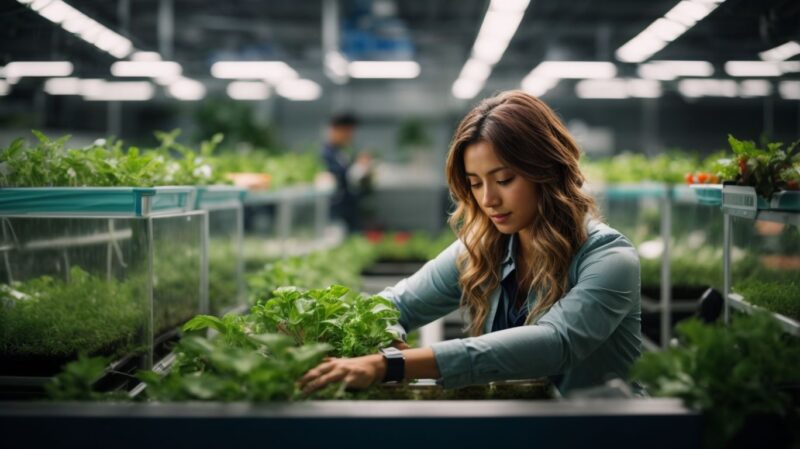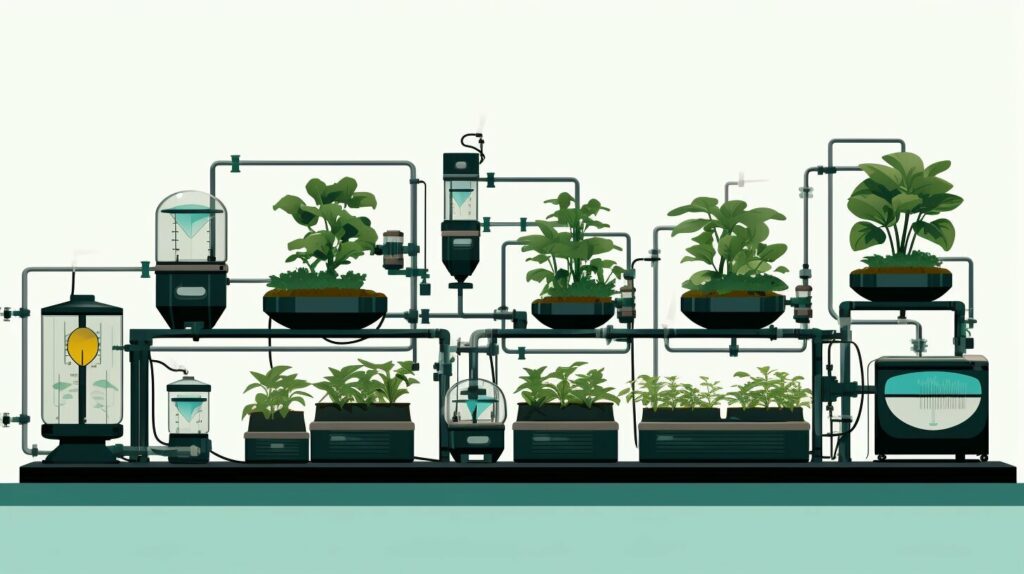This post may contain affiliate links and we may earn a small commission when you click on the links at no additional cost to you. As an Amazon Affiliate, we earn from qualifying purchases. You can read our full disclaimer here.
If you’re an aquaponic farmer, you know that maximizing crop yield is crucial for sustainable and profitable results. However, achieving high-yield results requires more than just planting crops and raising fish. It requires expert techniques that can help you optimize water quality, nutrient balance, planting strategies, and more.
In this section, we’ll explore the importance of expert techniques in maximizing yield in aquaponics and provide insights on how you can implement them in your farming practices.
Key Takeaways:
- Expert techniques can help you achieve higher crop production and sustainable results in aquaponics.
- Optimizing water quality, nutrient balance, planting strategies, and pest control are some key areas where expert techniques can significantly impact.
- Regular monitoring and adjusting system parameters, harvesting, and crop rotation strategies are essential for maximizing yield and maintaining sustainability in aquaponics.

Understanding the Benefits of Aquaponics and Maximizing Yields
Suppose you’re looking for a sustainable and efficient way to grow crops. In that case, aquaponics may be the solution you’ve been searching for. This unique farming method offers numerous benefits that traditional agriculture can’t match.
One of the primary advantages of aquaponics is its ability to conserve water. Aquaponics is a more efficient farming method that minimizes water usage by recycling the same water between fish and plant systems, unlike traditional farming methods that require large amounts of water for irrigation. Additionally, the nutrients in the water from fish waste provide a natural fertilizer for the plants, eliminating the need for chemical fertilizers.
Another benefit of aquaponics is its minimal environmental impact. Farmers can avoid much of the soil erosion and water pollution associated with traditional farming practices. Aquaponics also minimizes the risk of introducing harmful chemicals and pesticides into the environment by using a closed-loop system.
More than just an environmentally-friendly option, aquaponics also offers a range of other advantages. For example, it requires less space than traditional farming methods, making it an ideal choice for urban agriculture. It also provides a balanced ecosystem for both plants and fish, with each system supporting the growth of the other.
Whether you’re a commercial farmer, backyard gardener, or just interested in sustainable agriculture, aquaponics offers numerous benefits to help you achieve your goals. Using this innovative farming method, you can conserve resources, minimize environmental impact, and grow delicious, healthy crops.
Exploring Aquaponics Systems and Methods
Aquaponics is a method of farming that promotes sustainability by growing aquatic animals and plants in a mutually beneficial system. Several methods and systems are available for aquaponic farming, each with unique benefits and considerations.
Media-based Aquaponics
Media-based aquaponics utilizes a grow bed filled with a medium such as gravel, clay pellets, or expanded shale. The plants grow in the medium, periodically flooded with nutrient-rich water from the fish tank. As the water drains back into the tank, it is filtered by the roots of the plants, removing harmful waste and toxins.
Nutrient Film Technique (NFT)
NFT involves using a narrow channel or trough in which a thin film of nutrient-rich water flows over the roots of the plants. The plants are supported by a platform or net pot, which allows the roots to dangle in the water. The water is then returned to the fish tank, which is filtered and recirculated.
Deep Water Culture (DWC)
DWC is a method in which the plant roots are suspended in a deep pool of nutrient-rich water. The system utilizes air stones or diffusers to provide oxygen to the water, which helps to maintain healthy plant growth. The water is filtered and regularly replenished to ensure optimal nutrient levels.
Each aquaponics system has its own benefits and considerations. Media-based systems are more forgiving when maintaining system parameters, making them a good option for beginners. NFT systems are ideal for plants with shallow roots, like lettuce, and have a high yield potential. DWC systems are great for larger plants like tomatoes and provide a more stable environment for root growth.
Optimizing Water Quality for Enhanced Yield
One of the most important factors in maximizing yield in aquaponics is maintaining optimal water quality. By carefully monitoring and managing pH, ammonia, nitrate, and oxygenation, you can ensure that your plants receive the nutrients they need to thrive.
| Technique | Description |
|---|---|
| Monitor pH Levels | Keep an eye on the pH levels in your aquaponic system to ensure that they remain within the range of 6.8-7.2. Fluctuations outside this range can lead to nutrient deficiencies, negatively impacting plant growth and yield. |
| Manage Ammonia and Nitrate Levels | Ammonia and nitrate are essential plant nutrients, but high levels can be toxic to fish. Regularly test your system’s water and adjust the feed or water flow rates to maintain safe plant and fish levels. |
| Maintain Proper Oxygenation | Plants, and fish both require oxygen to thrive. Ensure your system is oxygenated correctly by using an air pump or a water flow rate that creates enough surface agitation to allow for gas exchange. Ensuring that your plants receive sufficient oxygen is crucial for their growth and to produce a high yield. |
Monitoring and adjusting your aquaponic system’s water quality is essential for maximizing crop yield. Ensuring your plants have the proper conditions will help them receive the necessary nutrients to grow and produce sustainable, high-yield results.
Fine-Tuning Nutrient Balance for Maximum Growth
To maximize yield in your aquaponics system, achieving the right balance of nutrients for your plants is crucial. A lack or overabundance of specific nutrients can negatively impact plant growth and yield. Here are some expert techniques to help you fine-tune your nutrient balance:
- Adjust fish feed: The type and amount of fish feed you use can affect nutrient levels in your aquaponics system. Opt for a high-quality fish feed to provide a balanced diet for your fish and ensure they produce the right amount of waste for your plants.
- Add supplements: If your system lacks specific nutrients, consider adding supplements to balance the nutrient levels. You can use organic fertilizers or water-soluble nutrients such as seaweed extract or fish emulsion.
- Monitor nutrient uptake: By regularly testing the nutrient levels in your system, you can adjust your feeding and supplementing accordingly. Monitor the pH, ammonia, nitrate, and phosphate levels and adjust as needed.
By fine-tuning your nutrient balance, you can optimize plant growth and achieve maximum yield in your aquaponics system. Remember that different plants have different nutrient requirements, so it’s important to research the specific needs of your growing crops.
Implementing Effective Planting Strategies
Now that you have optimized your water quality and nutrient balance, it is time to focus on planting strategies to maximize your yield. Here are some aquaponics techniques to consider:
Companion Planting
Companion planting involves cultivating plants close to each other to promote mutual benefits. For example, planting herbs like basil or mint alongside your vegetables can repel pests and attract beneficial insects, helping your plants grow healthier and yield more. Furthermore, certain plants can help other plants absorb nutrients more efficiently, maximizing crop production.
Vertical Gardening
In an aquaponics system, space utilization is vital. Using vertical gardening techniques, you can grow more plants in less space. For example, you can use trellis nettings like VIVOSUN Heavy-Duty Polyester Plant Trellis Netting or develop towers to maximize your use of vertical space. This allows you to grow more plants overall and increase your yield without taking up more floor space in your aquaponics setup.
Proper Spacing
Plants need room to grow, and overcrowding can lead to stunted growth and reduced yields. By adequately spacing your plants, you can ensure they have the space to grow and thrive. This will allow for better access to light and nutrients, which will, in turn, lead to higher yields.
Implementing these aquaponics techniques allows you to optimize your planting strategies and maximize your crop yield. Remember to always keep an eye on your system and make adjustments as necessary to ensure your plants are healthy and productive.
Managing Pest Control in Aquaponics
As an aquaponic farmer, you need to be aware of the challenges posed by pests and their potential impact on your crops. Fortunately, you can use several expert techniques to prevent and manage pests in your aquaponic system.
Natural Pest Deterrents
One effective way to deter pests in your aquaponic system is by introducing natural pest repellents, such as garlic, onions, or chili peppers. To discourage pests, you can utilize essential oils such as neem or peppermint. These natural remedies are also safe for your plants, fish, and the environment.
Beneficial Insects
Another way to manage pests is by introducing beneficial insects that prey on pests. Ladybugs, lacewings, and praying mantises are some insects you can introduce into your system to help control pest populations. However, ensuring that these insects do not harm your plants or fish is important.
Maintaining a Healthy Ecosystem
Maintaining a healthy balance in your aquaponic ecosystem is another important technique to prevent pest infestations. This involves ensuring optimal water quality, providing proper lighting and temperature conditions, and keeping the system clean. Regularly removing dead leaves, algae, and other debris can prevent pests from finding a foothold in your system.
You can effectively prevent and manage pests in your aquaponic system by employing these expert techniques. You can maintain sustainable, high-yield crops by ensuring a healthy ecosystem, introducing natural pest deterrents, and using beneficial insects.
Fine-Tuning Lighting and Temperature Control

Proper lighting and temperature control are crucial factors for optimizing plant growth and yield in aquaponics. You can ensure maximum productivity and healthy crop growth by providing the right conditions. Here are some expert aquaponics techniques to fine-tune lighting and temperature control:
Using Grow Lights
Grow lights are an excellent solution to provide sufficient light to plants in an indoor aquaponics system. They mimic natural sunlight and provide a consistent light source for plants, which can help promote growth. When using grow lights, it’s essential to consider the light’s intensity, spectrum, and duration. Plants require different spectrums of light during various stages of growth. Therefore, you should use specialized lights that are designed for plant growth. You may find product roundups of grow lights here.
Shading
Shading can be an effective way to control temperature and light intensity in outdoor aquaponics systems. You can use shade cloths or other materials to shade your plants during the hottest day. This will help prevent overheating and ensure your plants receive the right light.
Monitoring Temperature Fluctuations
Temperature fluctuations can affect plant growth and yield in your aquaponics system. Monitoring the water temperature regularly and maintaining a consistent temperature range is essential. Plants usually grow best when the temperature is between 70-85°F (21-29°C), but it may vary based on the type of plant.
Using these aquaponics techniques for fine-tuning lighting and temperature control can help you achieve optimal conditions for your plants to thrive and improve your overall yield.
Monitoring and Adjusting System Parameters
One of the most significant aquaponics techniques that can help you maximize yield Is monitoring and adjusting system parameters. To ensure plants grow at their best, monitoring different factors like water flow, oxygen levels, and nutrient concentrations is essential. Regular maintenance and adjustments are crucial to ensure the best conditions for healthy plant growth and maximum yield.
To keep your system running smoothly, ensure that water flow is consistent and all pipes and drains are working correctly. Monitoring oxygen levels regularly is essential to ensure your fish and plants are getting enough oxygen. If your water is not appropriately oxygenated, your plants may not grow well, yielding less.
Maintaining the right balance of nutrients in aquaponics is essential. Monitoring pH levels to ensure that nitrogen and phosphorus levels are balanced for optimal plant growth is vital. You can adjust the pH level by adding pH up or pH down solutions to the water. However, it is always advisable to test the pH levels regularly and make adjustments slowly to avoid sudden changes that may harm your plants and fish.
| Parameter | Optimal Range |
|---|---|
| Water Temperature | 20-25°C |
| pH Level | 6.8 to 7.2 |
| Ammonia Levels | 0 ppm |
| Nitrate Levels | 40-60 ppm |
| Oxygen Levels | 5-7 ppm |
Regularly testing and monitoring your water quality can help you stay on top of these parameters, allowing you to adjust your system accordingly. It is also essential to check your fish feed and adjust it accordingly, as excess fish feed can lead to high levels of nutrients, harming your plants and fish.
Overall, regular monitoring and adjustments are crucial for maximizing yield in aquaponics. By closely monitoring your system parameters, you can ensure that your plants are getting the best growing conditions possible, leading to healthier, more productive plants and higher yields!
Harvesting and Crop Rotation Strategies

In aquaponics, harvesting techniques play an essential role in maximizing yield. The timing and proper procedures for harvesting different crops are crucial to maintaining a healthy ecosystem and preventing nutrient depletion. Here are some expert techniques to help you harvest your crops effectively:
- Harvest leafy greens from the outer edges of the plant first. Encouraging new growth and preventing the plant from toppling over is crucial.
- For fruits and vegetables, wait until they’re fully mature before harvesting. This will ensure maximum flavor and nutrient density.
- To reduce harm to the plant and avoid spreading disease, it is crucial to utilize sharp and sanitary tools.
Crop rotation is another important technique for maximizing yield in aquaponics. Regularly rotating your crops can help prevent nutrient depletion and minimize the chances of disease and pest infestations. Here are some tips for effective crop rotation:
- Rotate crops according to their nutrient needs. For example, plants that are heavy nitrogen feeders should be followed by plants that are heavy phosphorus feeders.
- Rotate crops by family. This will prevent the buildup of pests and diseases that affect specific plant families.
- Plant cover crops in between harvests to help replenish nutrients in the soil.
By following these expert techniques for harvesting and crop rotation, you can maintain a healthy ecosystem and achieve maximum yield in your aquaponics system.
Conclusion
Congratulations! You now possess a comprehensive knowledge of expert techniques that can be utilized to enhance yield in aquaponic gardening. By implementing these techniques, you can achieve sustainable, high-yield results and enjoy the many benefits of aquaponics.
Remember, maintaining optimal water quality, nutrient balance, and lighting and temperature control are crucial for achieving maximum yield. Effective planting strategies, pest control, and monitoring and adjusting system parameters can help you fine-tune your aquaponic system and achieve even better results.
Remember the importance of harvesting and crop rotation strategies. Proper timing and techniques for harvesting different crops and rotating plant varieties will help prevent nutrient depletion and keep your system running smoothly.
We hope you found this article helpful in your aquaponic gardening journey. By applying these expert techniques, you can take your aquaponic garden to the next level and enjoy a sustainable, thriving ecosystem for your plants and fish.




Pingback: Plant Grow Lights for Aquaponics: A Comprehensive Guide - Aquaponics Daily
Pingback: Relationship Between Aquaponics Research and Industry Growth - Aquaponics Daily
Pingback: Ecological Principles of Aquaponics - Aquaponics Daily
Pingback: Routine Care Practices for Healthy Aquaponics Plants